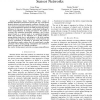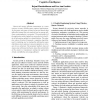1398 search results - page 23 / 280 » Energy Conservation in Reliable Wireless Sensor Networks |
177
click to vote
ICDE
2006
IEEE
16 years 1 months ago
2006
IEEE
Wireless sensor networks generate a vast amount of data. This data, however, must be sparingly extracted to conserve energy, usually the most precious resource in battery-powered ...
117
click to vote
TON
2010
14 years 6 months ago
2010
Abstract--Energy efficiency is critical for wireless sensor networks. The data-gathering process must be carefully designed to conserve energy and extend network lifetime. For appl...
GLOBECOM
2008
IEEE
15 years 6 months ago
2008
IEEE
—Wireless Sensor Networks (WSNs) consist of spatially-distributed autonomous sensors that can cooperatively monitor physical and environmental conditions. Because of sensors’ r...
152
click to vote
INFOCOM
2011
IEEE
14 years 3 months ago
2011
IEEE
—For energy conservation, a wireless sensor network is usually designed to work in a low-duty-cycle mode, in which a sensor node keeps active for a small percentage of time durin...
106
click to vote
CNSR
2008
IEEE
15 years 6 months ago
2008
IEEE
Secure and energy efficient transmission is a main concern in many wireless sensor network applications. In this paper, two types of denial-of-service attacks that affect the rout...


